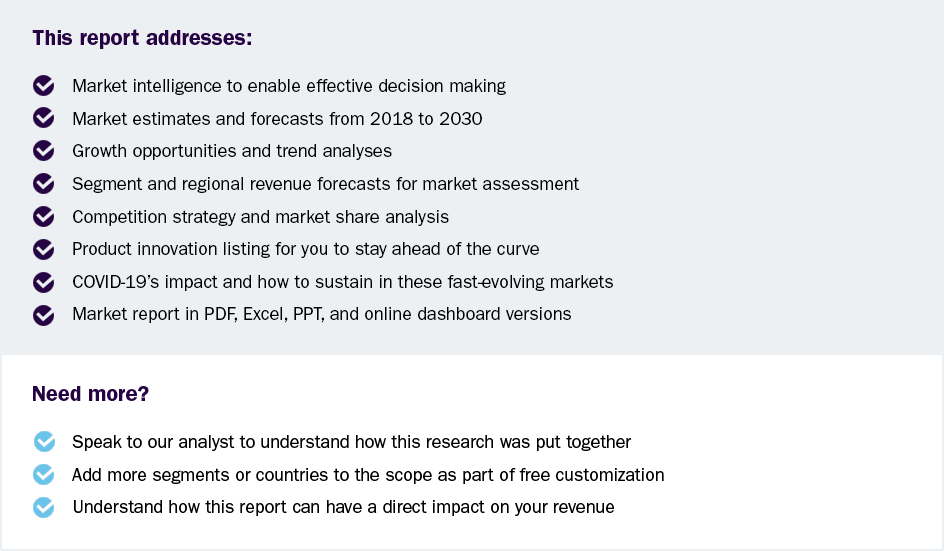Cell Counting Market Size To Reach $15.46 Billion By 2030
Cell Counting Market Growth & Trends
The global cell counting market size is expected to reach USD 15.46 billion in 2030 and is projected to grow at a CAGR of 8.7% from 2025 to 2030. Rising prevalence of chronic diseases such as cancer, HIV, and Alzheimer’s is the high impact rendering growth driver of the industry. Increasing prevalence of these diseases has surged clinical research activities, consequently propelling the demand for cell counting instruments and consumables. Government initiatives working to promote the development of cell therapeutics, wherein cell counting plays an imperative role, are also expanding growth prospects for the market.
An increase in the number of collaborations of research institutes with various public and private entities to promote R&D has provided a significant boost to growth. Growing number of proposed guidelines and recommendations for public and private laboratories to ensure high-quality standards and facilitate the generation of accurate results are likely to improve the adoption of instruments over the coming years. For instance, in May 2021, the International Society for Stem Cell Research updated guidelines for the development of cell-based therapy and research. The proposed guidelines focus on all stages of R&D and improve the quality of preclinical studies.
Technological advancements in these devices are also broadening growth prospects of the market. One of the promising technological advancements in differential cell counting is the ability to recognize blasts, immunoplatelet counting, detection of blasts, and reticulocyte fractions and stem cell counting with greater accuracy. The advent of CD4+ T-cell counting technology has proven to be very useful as an indicator of immune responses and has been adopted to evaluate the success or failure of Anti-retroviral Therapy (ARV). Dedicated cytometers are present in the market to perform CD4+ and CD8+ T-cell enumeration, such as the FACSCount by Becton Dickinson is based on T-cell counting technology.
The COVID-19 pandemic is anticipated to positively impact industry growth. WBC count of the COVID-19 patient during admission is significantly correlated with the death of patients. A higher level of white blood count should be given further care in the COVID-19 treatment. The growing importance of cell count in patients suffering from COVID-19 has augmented the growth of the industry during the pandemic.
The development of enhanced informatics solutions and improved image analysis instruments such as optical or fluorescence microscopes have fueled the growth prospects of this market. These instruments are being increasingly adopted in low sample throughput laboratories and settings with limited resources, which is highly prevalent in developing economies, thereby broadening the scope for growth of the industry.
On the other hand, limited availability of skilled professionals is the critical growth-restraining factor of the market. The lack of skilled professionals can be attributed to a lack of training facilities and high training costs. In order to improve this scenario, industry players are required to participate in the generation of training programs for software developed by these companies and encourage healthcare professionals and researchers to operate cell counting software. Moreover, the lack of standardization of these software tools also plays a key role in restricting researchers and healthcare professionals as every software differ in user interface.
 Request a free sample copy or view report summary: Cell Counting Market Report
Request a free sample copy or view report summary: Cell Counting Market Report
Cell Counting Market Report Highlights
-
By product, consumables and accessories segment accounted for the largest revenue share of 54.0% in 2024 and is expected to grow at the fastest CAGR of during the forecast period
-
The microplates sub-segment is poised to expand at the fastest CAGR during the forecast period. Microplates are usually used for analyzing very low concentration samples. The increased consumption of these plates is attributed to the repeated need to use fresh plates for analyzing a new sample to prevent contamination
-
In the instruments segment, automated cell counters are anticipated to grow at an exponential rate during the forecast period. Benefits such as short testing time, reduced error occurrence, and inter-operator variability are expected to further increase the demand for automated counters
-
By application, the complete blood count segment held the largest revenue share of 59.4% in 2024. The large revenue share can be attributed to increasing incidence of blood disorders
-
In the end-use segment, research and academic institutes accounted for the largest revenue share of 39.8% in 2024 owing to growing number of government initiatives focused on promoting R&D in various toxicology studies
Cell Counting Market Segmentation
Grand View Research has segmented the global cell counting market report based on product, application, end use, and region
Cell Counting Product Outlook (Revenue, USD Million, 2018 - 2030)
-
Instruments
-
Spectrophotometers
-
Flow Cytometers
-
Hemocytometer
-
Automated Cell Counters
-
Microscopes
-
Others
-
-
Consumables & Accessories
-
Reagents
-
Microplates
-
Others
-
Cell Counting Application Outlook (Revenue, USD Million, 2018 - 2030)
-
Complete Blood Count
-
Automated Cell Counters
-
Manual Cell Counters
-
-
Stem Cell Research
-
Cell Based Therapeutics
-
Bioprocessing
-
Toxicology
-
Others
Cell Counting End Use Outlook (Revenue, USD Million, 2018 - 2030)
-
Hospitals & Diagnostic Laboratories
-
Research & Academic Institutes
-
Pharmaceutical & Biotechnology Companies
-
Others
Cell Counting Regional Outlook (Revenue, USD Million, 2018 - 2030)
-
North America
-
U.S.
-
Canada
-
Mexico
-
-
Europe
-
UK
-
Germany
-
France
-
Italy
-
Spain
-
Denmark
-
Sweden
-
Norway
-
-
Asia Pacific
-
Japan
-
China
-
India
-
Australia
-
South Korea
-
Thailand
-
-
Latin America
-
Brazil
-
Argentina
-
-
Middle East & Africa
-
South Africa
-
Saudi Arabia
-
UAE
-
Kuwait
-
List of Key Players in Cell Counting Market
-
Thermo Fisher Scientific Inc.
-
Merck KGaA
-
Agilent Technologies, Inc.
-
PerkinElmer
-
BD
-
Danaher Corporation
-
Bio-Rad Laboratories, Inc.
-
GE HealthCare
-
DeNovix

